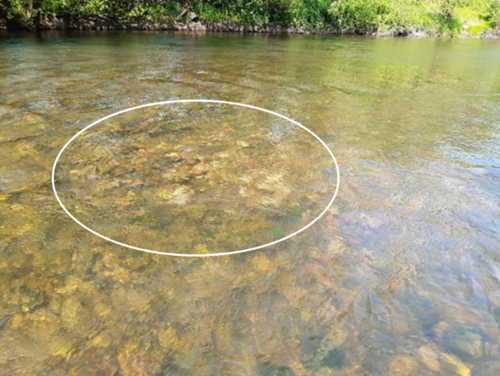World Fish Migration Day – Sea lamprey

Its World Fish Migration Day on Saturday 25 May and to celebrate we are putting the spotlight on the rare sea lamprey.
Here Sophie Gott, Four Rivers for LIFE Monitoring Officer at Natural Resources Wales (NRW) talks about this fascinating creature and what it needs for its successful migration journey.
Lampreys are a prehistoric eel-shaped fish that have been around for nearly 400 million years.
They have a disc-shaped, suction cup mouth ringed with sharp teeth, which they use to attach to their prey when feeding or to move stones when building their redds (nests).
There are three species of lamprey; river, brook and sea, and all are found in the UK.
Numbers have declined in recent years, and they are all now classed as a rare and protected species. No fishing is allowed for any of the species.
They are listed as a Priority Species under the UK Post-2010 Biodiversity Framework and are a designated and protected species for the River Teifi, Tywi, Cleddau and Usk Special Area of Conservation (SAC).
They are also listed on the International Union for Conservation of Nature (IUCN) Red List of Threatened Species.
Breeding and migration
The sea lamprey (Petromyzon marinus) is the largest of the three lamprey species in the UK, with some measuring up to one metre in length (see below image).

Sea lamprey are anadromous, meaning they migrate from the sea to spawn (breed) in freshwater, like salmon.
During this migration which happens during May and June the adults don't feed, focussing all their energies on getting to suitable spawning grounds.
Sea lamprey often spawn in deeper sections of river than brook or river lamprey. This is followed by a larval phase (ammocoete phase) spent in suitable silt beds in streams and rivers.
Once hatched, the larvae (ammocoetes) drift with the flow to bury themselves in the soft marginal silt of the river to grow, feeding on the algae, bacteria and detritus in the mud.
After several years in these silt beds, sea and river lamprey ammocoetes cease feeding and start transforming (metamorphosing). Then in mid to late summer they form into an adult with functional eyes and the mouth changes into a sucker (or oral disc) with teeth.
They will then migrate out to sea and start to feed parasitically on fish such as cod, mackerel or rays. The lamprey will latch onto a fish with their ringed teeth and rasp away, consuming flesh, blood and even internal organs.
After spending 1-2 years at sea feeding, the sea lamprey migrates back into freshwater rivers to spawn and the cycle begins again.
Unlike salmon, sea lamprey are not thought to ‘home’ to the stream in which they were born, but are able to find suitable spawning streams by picking up pheromones from ammocoetes already living in there.
Sea lamprey spawn in pairs or small groups, in a shallow depression (redd) created by wriggling their bodies in the substrate or using their suckers to move stones about. Watch Jack Perks’ video on lamprey to see this for yourself 300 Million Year Old Fish: Chasing Scales Species Hunt (EPISODE 10) (youtube.com)
These redds (nests) can often be seen from the riverbank or from bridges, looking like clean areas of about 1-2metre diameter in the riverbed (see image below).

The female will deposit the fertilised eggs in the redd, where they are protected from most predators, and provided with clean, well oxygenated water in which to develop and hatch.
After they breed both female and male lamprey die.
What are the pressures facing sea lamprey populations?
As with many of our freshwater species, the biggest threat to lamprey are habitat loss and pollution.
Soil and sediment eroding from land next to rivers can fill in gaps between cobbles and gravel at the bottom of our rivers, smothering the habitat that lamprey need to lay their eggs and preventing oxygen from reaching the eggs.
In addition, man-made structures like weirs and dams can hamper migration. Lamprey are not able to jump and instead will have to swim or ‘sucker’ their way over barriers.
This slows them down and wastes valuable energy needed in their search for breeding areas further upstream.
How are we helping sea lamprey?
The Four Rivers for LIFE project is working with partner organisations, farmers, landowners, local communities and contractors to help restore populations of sea lamprey.
The project will reduce excess silt and sediment from entering rivers by creating riverside habitat, improve natural processes in rivers by introducing gravel and boulders to create important breeding habitat.
The project will also adapt or remove constraints like weirs and other structures in the rivers, this will open up access further upstream to areas where the lamprey can breed.
To keep up to date with our work you can follow us on Facebook, X and Instagram or subscribe to our newsletter here
